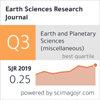Physico-chemical and mineralogical changes of lithic xerorthent soils on volcanic rocks under semi-arid ecological conditions
IF 0.5
4区 地球科学
Q4 GEOSCIENCES, MULTIDISCIPLINARY
引用次数: 0
Abstract
This study investigates the mineralogical changes and soil development processes of young soils formed on various bedrocks of volcanic origin under the same land use/land cover and climate conditions. The current study was conducted in Lithic Xerorthent soils formed on tuff, trachybasalt, and trachyandesite bedrock between Sandıklı-Şuhut districts of Afyonkarahisar. The three soil profiles excavated in the study area were classified in Entisols order based on Soil taxonomy. The primary minerals, sanidine and muscovite, and the clay minerals, smectite, kaolinite, and illite, were widely determined in three soil profiles which were named Profile I (PI), Profile II (PII), and Profile III (PIII). According to the chemical alteration index (CIA) values, which indicate weathering, the soils formed on the tuff bedrock were slightly weathered (77.04%). The chemical weathering index (CIW) in the soils' surface horizons formed on the trachybasalt and trachyandesite bedrock are classified as non-weathering rocks with 24.43% and 33.88%. Basic cations are found at high levels in the tuff bedrock. The determination of phillipsite, gismondin and calcite minerals is an indication that the mineral content of the bedrock and the bedrocks have a significant effect on soil formation. The relationship between the bedrock and the soil has been revealed. As a result of the study, it was concluded that there were significant differences in their physico-chemical characteristics, weathering rates, and mineralogical properties. However, they were characterized as young soils since they do not contain any subsurface diagnostic horizons on the volcanic bedrock under the same climatic and land use/land cover conditions.半干旱生态条件下火山岩上岩屑状均匀土的理化矿物学变化
研究了在相同土地利用/土地覆被和气候条件下,不同火山岩基岩上形成的幼嫩土壤的矿物学变化和土壤发育过程。目前的研究是在Afyonkarahisar的Sandıklı-Şuhut地区之间的凝灰岩、粗面玄武岩和粗面山岩基岩上形成的岩屑变径土中进行的。根据土壤分类学对研究区出土的3种土壤剖面进行了完整的分类。在剖面I (PI)、剖面II (PII)和剖面III (PIII)中广泛发现了原生矿物白石和白云母,粘土矿物蒙脱石、高岭石和伊利石。根据指示风化作用的化学蚀变指数(CIA)值,凝灰岩基岩上形成的土壤有轻微风化作用(77.04%)。在粗面玄武岩和粗面山岩基岩上形成的土壤表层化学风化指数(CIW)分别为24.43%和33.88%,属于非风化岩。碱性阳离子在凝灰岩基岩中含量很高。phillipsite、gismondin和方解石矿物的测定表明基岩和基岩的矿物含量对土壤的形成有显著的影响。基岩和土壤之间的关系已经显露出来。研究结果表明,它们在理化特征、风化速率和矿物学性质上存在显著差异。然而,它们的特征是年轻土壤,因为在相同的气候和土地利用/土地覆盖条件下,它们在火山基岩上不包含任何地下诊断层。
本文章由计算机程序翻译,如有差异,请以英文原文为准。
求助全文
约1分钟内获得全文
求助全文
来源期刊

Earth Sciences Research Journal
地学-地球科学综合
CiteScore
1.50
自引率
0.00%
发文量
0
审稿时长
>12 weeks
期刊介绍:
ESRJ publishes the results from technical and scientific research on various disciplines of Earth Sciences and its interactions with several engineering applications.
Works will only be considered if not previously published anywhere else. Manuscripts must contain information derived from scientific research projects or technical developments. The ideas expressed by publishing in ESRJ are the sole responsibility of the authors.
We gladly consider manuscripts in the following subject areas:
-Geophysics: Seismology, Seismic Prospecting, Gravimetric, Magnetic and Electrical methods.
-Geology: Volcanology, Tectonics, Neotectonics, Geomorphology, Geochemistry, Geothermal Energy, ---Glaciology, Ore Geology, Environmental Geology, Geological Hazards.
-Geodesy: Geodynamics, GPS measurements applied to geological and geophysical problems.
-Basic Sciences and Computer Science applied to Geology and Geophysics.
-Meteorology and Atmospheric Sciences.
-Oceanography.
-Planetary Sciences.
-Engineering: Earthquake Engineering and Seismology Engineering, Geological Engineering, Geotechnics.
 求助内容:
求助内容: 应助结果提醒方式:
应助结果提醒方式:


